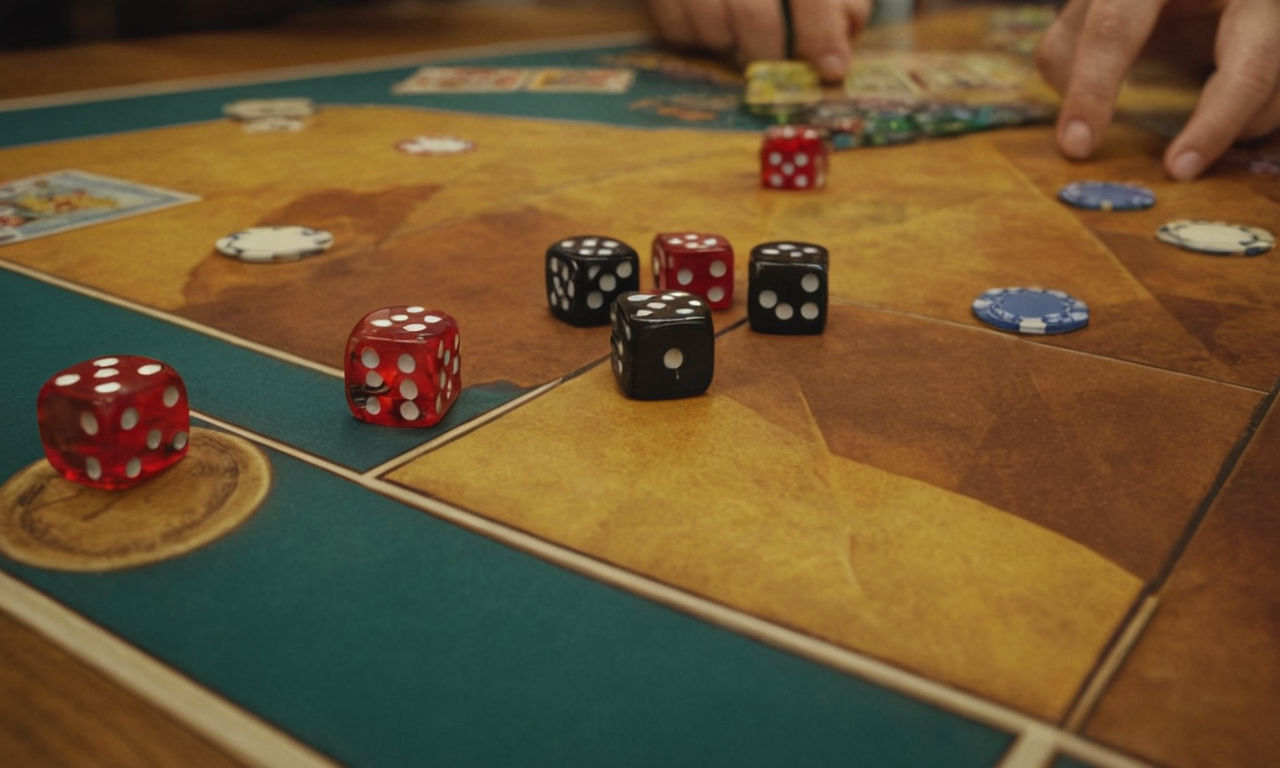Introduction
In the realm of board games, the sequence of turns, often referred to as "turn order," holds a pivotal role in shaping the gameplay dynamics. The strategic importance of deciding turn order can significantly influence the outcomes of games, making it a critical aspect that requires careful consideration from players. Understanding the implications of turn order decisions is essential for optimizing one's gameplay strategy and gaining a competitive edge in various board game scenarios.
When players delve into the intricacies of turn order, they uncover a strategic layer that goes beyond mere chance. The sequential order in which players take their turns can have profound effects on the overall game progression, influencing decisions, resource management, and tactical maneuvers. By correctly navigating the complexities of turn order dynamics, players can potentially tilt the odds in their favor, leading to more favorable outcomes and enhanced gameplay experiences.
Why Turn Order Matters
The importance of turn order in board games transcends mere sequential gameplay mechanics and emerges as a strategic cornerstone that can dictate the flow of the entire gaming experience. Here are some reasons why understanding and leveraging turn order is paramount:
Impact on Strategy: Turn order can significantly affect the strategic decisions players make throughout the game. Going first may allow a player to secure valuable resources or claim advantageous positions, while going last could provide insights into opponents' actions and enable more calculated moves.
Influence on Decision-Making: The sequence in which players take their turns can reshape the decision-making process. Players positioned earlier in the turn order might have to make decisions with limited information, whereas those going later can adapt their strategies based on preceding actions.
Crucial Role in Games: Turn order often plays a crucial role in determining the winner of a game, especially in scenarios where timing and resource management are key factors. Games like "Terra Mystica" and "Puerto Rico" showcase how strategic turn order decisions can sway the outcome in favor of skilled players.
Understanding the intricate relationship between turn order, strategy, and decision-making is fundamental for players looking to master the art of board game tactics and optimize their gameplay performance.
Different Methods for Deciding Turn Order
In board games, the methods used to decide turn order can vary widely, each introducing unique dynamics and strategic considerations. Here are some common techniques employed in determining the sequence of turns:
Random Selection Techniques
Coin Flip: A classic method where players call the result of a coin toss to establish the initial turn order. This randomized approach adds an element of unpredictability to the game, challenging players to adapt to varying starting positions.
Dice Roll: Utilizing dice rolls to assign turn order provides a dynamic way of determining player sequence. The element of chance in rolling dice introduces a level of uncertainty that can spice up gameplay experiences.
Bid Systems
Auctions: Auction-based systems allow players to bid for their preferred turn order positions, introducing a strategic bidding element. Players must weigh the value of going first against the expenditure of in-game currencies or resources.
Resource Expenditure: Some games use resource expenditure mechanisms to establish turn order, where players spend their in-game resources to secure advantageous positions. This method requires careful resource management and strategic planning.

In-Game Performance
Speed-based Challenges: Certain games incorporate speed-based challenges or mini-games to determine turn order. Players who excel in these challenges are rewarded with preferred turn positions, rewarding skill and dexterity.
Skill-based Challenges: Skill-based challenges, such as puzzles or strategic tasks, can also be utilized to set turn order. This method promotes player engagement and adds a competitive edge to the process of determining who goes first.
By exploring these diverse methods for deciding turn order, players can enhance their strategic thinking, adaptability, and overall gaming experience across a wide array of board games and turn-based challenges.
Implications of Various Turn Order Methods
In the realm of board games, the method used to determine turn order can have significant implications on gameplay dynamics and the overall outcome of the game. Let's delve into the analysis of different turn order methods and their impacts:
Analysis of the impact of random selection on gameplay
Random selection of turn order, such as drawing cards or rolling dice, adds an element of unpredictability to the game. This can introduce a level of excitement and suspense as players are unsure of when they will have their turn. However, it can also lead to situations where a player consistently goes first or last, potentially affecting their ability to strategize effectively.
Strategic advantages and disadvantages of bid systems
Bid systems, where players compete to determine their turn order by offering resources or in-game currency, can introduce a strategic element to the game. Players must weigh the value of going first against the cost of bidding higher, making each decision impactful. While bid systems can add depth to gameplay, they can also lead to imbalances if one player consistently outbids others, potentially affecting the overall fairness of the game.
Influence of skill-based challenges on game dynamics
Introducing skill-based challenges to determine turn order, such as mini-games or trivia quizzes, can add a fun and interactive element to the game. This method rewards players for their abilities outside of the main gameplay mechanics and can level the playing field by giving all players an equal chance to earn the preferred turn order. However, skill-based challenges may also favor certain players with particular strengths, potentially skewing the balance of power in the game.
Strategies for Optimizing Turn Order Decisions
Strategic players understand the importance of optimizing turn order decisions to gain a competitive edge. Here are some key strategies to consider when navigating the intricacies of turn order:

Assessing the game's mechanics to leverage turn order
Each game has its unique mechanics that can influence the significance of turn order. Understanding how the game mechanics interact with the turn order can help players strategize effectively. For instance, in games where early turns have a significant impact on resource acquisition, going first may be advantageous, while in games with a reactive playstyle, going last could offer strategic benefits.
Long-term planning based on turn order
Successful players often plan their moves several turns in advance, taking into account how turn order may affect their actions. By considering the potential outcomes of different turn orders, players can anticipate their opponents' moves and adapt their strategies accordingly. Long-term planning based on turn order can help players stay ahead of the game and make informed decisions that align with their overall objectives.
Adapting strategies based on the chosen turn order method
Flexibility is key when it comes to adapting strategies based on the chosen turn order method. Whether the turn order is determined randomly, through bidding, or skill-based challenges, players must be prepared to adjust their tactics on the fly. Adapting strategies based on the chosen turn order method allows players to stay agile, react to changing circumstances, and maximize their chances of success.
Enhancing Gameplay Through Turn Order Tactics
Mastering turn order tactics can elevate gameplay experiences and give players a competitive advantage. Here are some ways to enhance gameplay through strategic turn order tactics:
Utilizing turn order to create diverse gameplay experiences: Strategic use of turn order can create varied and engaging gameplay experiences for all players. By incorporating elements like simultaneous actions or variable turn order sequences, games can offer dynamic and innovative mechanics that keep players on their toes.
Implementing turn-based strategies for competitive advantage: Players who understand the nuances of turn-based gameplay can leverage this knowledge to gain a competitive edge. By timing their actions strategically, anticipating their opponents' moves, and capitalizing on the initiative provided by favorable turn order, players can increase their chances of success and outmaneuver their rivals.
Examples of successful turn order tactics in popular board games: Many popular board games showcase the impact of turn order tactics on gameplay. Games like "Puerto Rico" reward players who plan ahead and adapt their strategies based on turn order, while titles like "Terra Mystica" challenge players to optimize their actions within the constraints of varying turn orders. Studying these examples can provide valuable insights into how turn order tactics can influence the outcome of games.
Introduction
In board games, the sequence in which players take their turns can significantly impact the outcome of the game. Understanding how to decide the turn order strategically is crucial for players looking to gain an advantage. By exploring different methods for determining turn order and their implications on gameplay, players can make informed decisions that may influence the overall result of the game.
Importance of Turn Order in Board Games
The turn order in board games plays a pivotal role in determining the flow of the game and ultimately, the strategies that players can employ. Here are some key reasons why turn order is crucial in board game tactics:

Strategic Advantage: The player going first might have a chance to claim key resources or positions before others, while the last player may benefit from observing opponents' moves.
Resource Management: Depending on the turn order, players may have access to limited resources or face greater competition for valuable assets.
Adaptability: Turn order can affect players' ability to react to changing game situations or opponents' strategies effectively.
Methods for Deciding Turn Order
1. Random Selection
Using dice rolls, card draws, or other random elements can introduce an element of chance into determining turn order.
2. Speed or Skill-Based Tests
Players may compete in a mini-game, trivia quiz, or other skill-based challenges to earn the right to choose their position in the turn order.
3. Auction Systems
Players bid resources or in-game currency to determine their position in the turn order, adding a strategic layer to the decision-making process.
Impact of Turn Order on Gameplay
The chosen method for deciding turn order can greatly influence the dynamics of the game. Consider these effects when analyzing game turn order strategies:
Early Advantage: Going first may allow a player to set the tone of the game or secure advantageous positions.
Late Game Momentum: Players going later in the turn order may have an opportunity to make impactful moves after observing earlier players' actions.
Balancing Factors: Certain games incorporate mechanisms to mitigate the disadvantages of going later in the turn order, ensuring a fair gameplay experience.
Real-World Example:
In the board game "Catan," turn order affects the distribution of initial settlements and allows players to strategically place their settlements and roads. Going first can be advantageous for securing prime locations, while later positions may enable players to react to opponents' moves strategically.
Conclusion
In conclusion, the decision of turn order in board games is a crucial aspect of gameplay that can significantly impact strategic choices and overall game outcomes. By understanding the implications of different methods for deciding turn order, players can enhance their decision-making skills and develop more effective game strategies. Implementing the insights gained from analyzing turn order strategies can lead to a more competitive and engaging gaming experience.
This article has explored the strategic importance of deciding game turn order, highlighting how it can influence gameplay dynamics and players' tactical decisions. Take these insights into consideration when crafting your board game strategies to maximize your chances of success and enjoyment in future gaming sessions.



